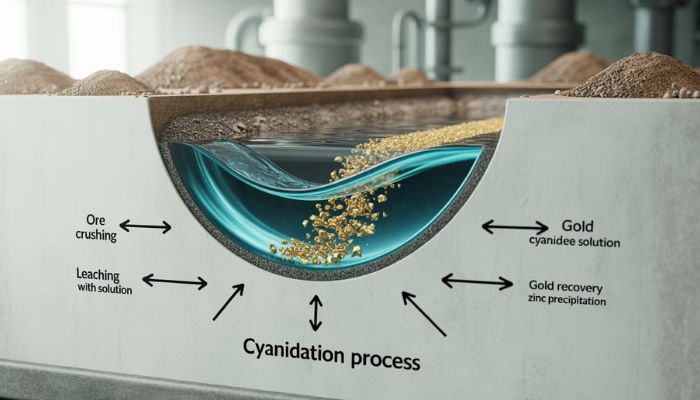On This Page
Table of Contents
Once ground, ore is transported by pumping to a series of large-diameter shallow tanks with porous false bottoms for storage and agitation via mechanical methods and airlift agitators. The cyanidation process begins in these percolation tanks, where a gold-containing solution is routed to a displacement precipitating device, the initial step in the cyanide gold extraction process, to precipitate the gold.
Cyanide Leaching of Gold: The First Step in the Cyanidation Process
A dilute form of sodium cyanide is added to gold ore, rendering its gold content soluble so it can be separated from the other minerals present. Once this slurry has formed, it’s treated with activated zinc or carbon (cementation) for maximum gold extraction.
Refractory ore deposits typically require pre-liming with alkaline water to allow for the removal of harmful materials, which is often done in its own mill.
At this stage, a mineral jig may be employed to separate any free gold from the ore before it enters the main cyanide circuit. Refractory ores require super-agitators for effective dissolving. Because every ore varies in its behavior during leaching processes, an extensive test program should be completed prior to proceeding with leaching operations.
Gold Cyanide: Understanding Its Role in Gold Extraction
Gold cyanide is an integral part of the industry, as it efficiently extracts gold from low-grade or complex ore. To protect the environment and ensure certification through the Cyanide Code.
Large-scale mining uses cyanide leaching on heaps of crushed ore piled atop collection pads. Cyanide solution is then sprayed onto these heaps before trickling down to collection tanks, where gold recovery rates range between 88%-98%. This highly scalable process can achieve recovery rates of between 85%-98%.
Aerating ore pulp prior to cyanidation can decrease oxygen consumption by allowing iron and sulfur atoms to transform to their non-cyanide forms, eliminating some consumption and improving leaching efficiency. Furthermore, it helps limit cyanide loss via the formation of thiocyanate byproducts, making this approach an attractive alternative to leaching for certain ores.
Cyanide Leaching for Gold: Key Techniques and Benefits
Cyanide leaching for gold mining operations is widely relied upon. The method can handle various ores with high gold recovery rates, and scale effortlessly from small mines processing 100 tons a day up to large operations processing thousands.
Cyanide Gold Extraction is widely acknowledged to be one of the most efficient methods of extracting precious metal from its ore, yet it does come with some environmental concerns. Accidental leaks from leach pads and tailings dams may release cyanide into water sources, polluting ecosystems with heavy metals while potentially leading to toxic health impacts and toxic waste disposal issues.
Mining companies must adhere to stringent protocols for managing cyanide. Furthermore, they should implement robust wastewater treatment and storage facilities, including double-lined leach pads and permanent tailings residue storage areas. Furthermore, independent third parties should conduct stringent inspections of processing plant operations using cyanide as part of ensuring its proper use in processing plants.
The Cyanide Process for Gold: How Cyanide Dissolves
In the cyanide gold extraction process, sodium cyanide is added to make insoluble minerals more soluble through complexation, producing an unstable gold-cyanide complex solution which can then be easily separated from leaching agents and extracted to obtain pure metal.
Plant practices generally limit the cyanide concentration in this solution to approximately 0.5% NaCN or 1 pound of cyanide per ton. Stronger solutions do not seem to accelerate dissolution or extraction processes and could even become harmful to people and the environment.
Lime is added to the solution in order to maintain a protective alkalinity level of 1/2 to 1 lb of alkali per ton of solution and limit loss due to oxidation; additionally, it has the added effect of hastening slime settlement in thickeners as well as precipitating certain unwanted substances.
Cyaniding for Gold: Explaining the Key Stages
Cyanide leaching of gold accounts for 90% of world gold production. Cyanide has proven its worth in extracting precious metals from low-grade and complex ores that cannot be processed using other techniques like gravity separation, flotation, or biorecovery.
A wetting agent may be added to cyanide solutions in order to decrease surface tension between ore and solution, accelerate leaching rates, and enhance gold recovery rates, as well as increase overall process efficiency. Furthermore, oxidation of iron compounds to sulfate ions before adding cyanide decreases consumption by converting ferrous cyanide to thiocyanate, which reduces consumption by an order of magnitude.
Thickeners are used to thicken cyanide slurry before it enters a tank for storage, creating a higher concentration and reduced pressure at the discharge end.
Cyanide Gold Extraction: The Essential Method for Modern Gold Mining
Gold mining operators are continually searching for more efficient ways to extract gold while cutting costs, often turning away from traditional cyanide processing techniques and finding alternatives like Linde’s dissolved gas management solutions as an invaluable asset in this pursuit.
Cyanide can be found both inside a controlled mill environment and in more unstructured heaps of mine tailings, where it is used to dissolve gold into water for easier separation from its surroundings. This chemical process makes gold mining simpler.
After grinding ore into fine powder, it is fed into a tank where weak solutions of sodium or potassium cyanide, often combined with lime, are added. This is known as vat leaching; when added, these weak solutions flow over the ore and bind with gold particles to make them water-soluble. Oxygen deficiency, slowing this reaction, may require aeriation, while vigorous agitation using methods like the mineral jig may also be beneficial in treating more difficult gold ores.
FAQs
What is cyanide leaching of gold?
Cyanide leaching of gold is a chemical process used to extract gold from ore. The process involves dissolving the gold using a dilute cyanide solution, which then allows the gold to be recovered.
How does the gold cyanide process work?
The cyanide process for gold works by adding cyanide to a crushed gold ore. The cyanide dissolves the gold into a solution, which can then be separated from the other minerals and recovered.
What is cyanide leaching for gold?
Cyanide leaching for gold is a method where gold ore is treated with a cyanide solution to extract the gold. This is one of the most common and efficient methods used in gold mining.
Why is cyanide used in gold mining?
Cyanide is used in gold mining because it effectively dissolves gold from ore, allowing for higher recovery rates compared to other methods. The cyanide solution helps separate the gold from other minerals in the ore.
Conclusion
The cyanidation process for gold extraction has revolutionized the mining industry, providing an efficient and effective method for extracting gold from ore. By using cyanide in gold mining, specifically through the technique of cyanide leaching, gold is dissolved and then recovered. This method, known as cyanide gold extraction, has become the standard process for gold cyanide leaching, ensuring the highest recovery rates in gold processing. Whether through direct cyanide use or advanced techniques like gold cyanidation, the process remains a crucial method for gold mining today. Despite its controversial nature due to environmental concerns, continuous improvements in cyanide gold mine management and safety measures ensure that cyanide remains a vital component in gold extraction. As the demand for gold rises, the cyanidation process for gold extraction is expected to remain a cornerstone of gold mining operations worldwide.
Read more about : How Cyanide Is Used in Gold Mining?



